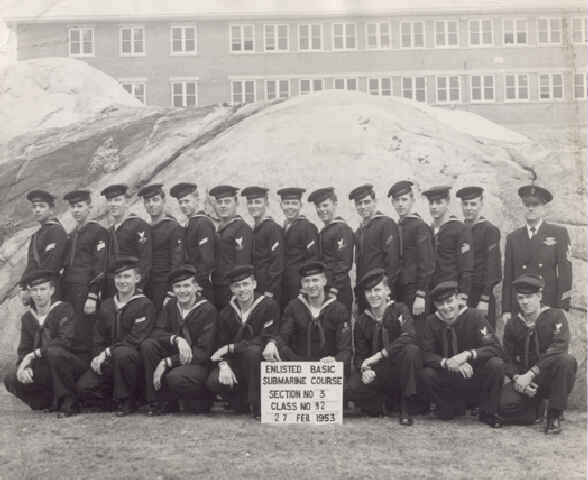
(I'm on the bottom row, second from the right.)
To return to memories of the SS 320,
click here.
To return to the main page of the SS 320, click here.
Memories of Richard Fredricks (formally Richard F. Schleffel), '52 - '53, SO2
From being paid to listen for sounds to singing for my supper.

(I'm on the bottom row, second from the right.)
Please visit my web site...
audio and video links and a great gallery of pictures...
richardfredricks.com
My very first dive in a boat was on the USS Tiru, a guppy snorkel out of Pearl. The Navy had yanked me off my AD and sent me to Pearl, to park me on a boat until a billet opened up in Sub School. Most of my time was spent with Tiru was at the 10-10 docks in a total sail/superstructure change... and I got to work from five in the afternoon until eight in the morning for two and a half months while the yardbirds toiled during the day. When I arrived, I found out our ET1 had decided to save the ship $40,000 by having us doing our own electronic maintenance and the yardbirds were pissed. Sooo, they sabotaged the QHB Sonar in the Conning Tower. It would be on for a bit, and then crash. I finally found the problem having tried every voltage/resistance check in the book. I just started pulling on the wires with a probe and... two of the wires came loose. The bad guys had pulled the insulation back on them, snipped the wires... and then slid the insulation back on. The Captain had a few words with the yard super.
My first dive was terrific. While I was aboard, no one took me seriously or in anyway took the time to instruct me on anything not related to the Sonar. While there, although I had taught Attack Teacher Sonar aboard my Tender, I knew nothing about the practical use of passive Sub Sonar so I took the two week course at the base. I came out top in a class of twelve! Good ears, you know!
The magic dive-day came and I essentially hung out in the control room (they wouldn't let me near the sonar at first and finally let me get on the JT) and our first dive was a stationary trim dive. It was OK until we left 65 feet, at ahead standard and planed down to about 100 feet when the bitchbox sounded the alarm that there was flooding in tubes forward. It was interesting to watch, knowing absolutely nothing about what was going on, everyone was cool with just a touch of urgency. They sealed the compartment and put in air and started the pumps but couldn't control the flooding. Finally, the skipper blew everything before it got too bad and up we went. Well... it turned out the yardbirds had put the lug nuts on the forward planes just tight enough to hold the packing in... sitting at the dock, but they had apparently forgotten to torque them to spec. (Now, wasn't there a check list somewhere, that someone was supposed to signoff, when that had been done?) When we got back to Pearl, my recollection is of the Skipper going across to the pier with the heaving line ... Heads rolled.
While on Tiru in the warm Pacific,
I picked up a convoy far to the east that first sounded just like a whisper
when I went across it. But I reported it anyway. It grew and grew over time
until we had multiple contacts and we just happened to be operating on
shake-down, to the west of Pearl. The officers figured it out that it was
Eisenhower coming across the pond in a carrier group (For two days previously,
six waves of six tincans came in advance of it. The skipper decided to go deep
and try to penetrate the formation, as the batho indicated we had a layer we
could hide under. We got in and he took her up snapping pix of the cruiser Ike
was on ... with not screen between us and him. He went deep again to miss the
trailing destroyer. Later on, we went in and the skipper went over with the
heaving line ... The blown up pix were hand delivered to the DesCom and fur flew
everywhere!!! Unfortunately, I missed all of the chatter in the conning tower as
I was in tubes forward for the event. It was guestimated that I picked the sound
source up over thirty miles ... They were making a lot of noise at about
twenty-five knots!
How could I forget ... The third class Quartermaster
who had the hydraulic lever for the periscopes brought the flange on #2 (the
attack scope) down on Kunhardt's head, but caught himself the instant it hit
him. It drew a little blood on the top of his forehead, but the guy was so
embarrassed he made it funny and he was well liked by the crew, so the Captain
blew it off! Classy Guy!
Snorkeling
We had to go to down to Key West, in the heat of summer, for snorkel
evaluation exercises ... six weeks of them! It had been determined that the
new covering (paint/plastic, whatever) on the mast had been difficult to pick
up on radar, so a full air/sea evaluation was ordered, our Navy plane's radar
and the most advanced radar on the Canadian destroyer, Algonquin--I believe
was its name--was brought down to check us out. Snorkeling in the warm/hot
water, six days a week, was a trial by heat. The air conditioning was
overwhelmed and I seem to recall the boat temp, with two engines running was
above 100 ... we were miserable. The three on deck pix, on my other website,
were taken during that trip. I think the skipper was cycling the troops
topside, between runs. On one such topside break, he had a "swim call,"
starboard side, positioning someone on the sail with a BAR, in case of sharks.
We were only in the water for maybe ten minutes--I was blithely swimming
along--when I heard the increasingly loud babble of 'fish or shark" or
something. None of us paused to ask what it was ... and we were all on deck in
less than thirty seconds! We walked over and looked down, portside, forward
... and there was this Bacaruda ... or Barracuda, quietly lying there, all
four feet of him/her ... and we had enough of swimming, for the day. Someone
got the brilliant idea of shark fishing, so down someone went for a big ol'
shark hook and chain--I don't know if he got it out of his locker or whether
is was ships issue--and brought up some meat, a five gallon milk can and a
heaving line. They caught two sharks, about five feet long ... and brought
them up on deck, if you can imagine such insanity. I don't recall who had the
deck, but no one stopped them. A couple of guys descended on them with big
kitchen knives and dispatched one of them, over a good period of time. The
other just wouldn't die so they just kicked him over the side. One fella cut
out some shark teeth. They kicked the carcass over ... and down we went again.
The most memorable snorkeling we ever did, was ten hour run, north, around
Cape Hatteras ... in a following sea. The details are a bit fuzzy but as I
recollect, I think we did it on the way back to New London ... Maybe Steve
O’Leary has a better memory than I. I think I was already qualified and off
watch, at the beginning of the run and only came into the control room,
because the skipper kept starting the run and would have to secure it after
several minutes. Because of the following sea, the current would come up under
the stern and we would have a significant, quick down bubble, from which the
planesmen were too slow to recover. With the mast under, the valve closed and
two running, it was pulling too much of a vacuum in the boat and the skipper
had to secure the run several times.
I watched for awhile and suspected that the stern plane was the key. The fella
on it was about wiped out, so I asked to give it a try. I quickly found that
the instant I felt the stern start to lift, I would anticipate it by going to
full rise, until it stopped ... and then to full dive, before the boat
developed too much inertia, that would take us past level.
Soooo, I did that for about an hour, full rise, full dive, until well past the
time I was ringing wet, while a bunch of guys watched. I then turned it over
to the next guy. I had to take it back a few times to steady it down until
they got the hang of it. Ya couldn't be a second late in acting or you would
loose the horizontal platform ... and we did that for ten hours!
I wonder if “Beartracks” remembers that and could fill it in some details.
Incidentally, before he signed me off on the control room–on this occasion, he
had the conn on the bridge–he told me I had to ask him two questions, he
couldn’t answer. I only remember one of them: what is the capacity of the low
pressure blower? 1500 cfpm! It'll be on the test!
Trying to make "1st"
Before I left the boat to be the only soundman for the Irex, on her
trip to the Med, I had asked him if he had put my recommendation for First,
into my record. He assured me that he had. I'm sure he meant to do it ... but
halfway across the pond, they posted those who were recommended for
advancement in rate ... and my name was missing. I tried to get Lcdr Brock to
send a Naval Speed Letter to the test center, to get one on the dock, for our
arrival in Naples, as well as asking him to send another NSL to Lt O'Leary,
for my recommendation ... but he refused saying, "You can take it next time.
You only just came aboard. We've got to get to know you." Boy ... I really
wanted to be a slick arm First. When I was getting out, Brock and the Captain
braced me against the bulkhead in the Forward Battery for forty-five minutes,
trying to get me to ship over. I reminded him of that previous rejection and
his response was, "If you ship over, we'll recommend you for OCS."
Actually ... he had already seen what I could do, with a week of PCS
exercises. Irex had been so long without a soundman--about eight months, con
you imagine--that I had to repeat everything two, three, four times, before I
would get a lame-ass, "Oh ... uh ... aye sonar ..."
Then, guess who came aboard PCS week? My ol' Exec. LCdr Jeffrey! There
were five of them and day and night, Monday through Friday, I was on the
stack. I was so tired late Thursday night--I think it was--I fell asleep for a
few seconds, but woke up to, "What's he doing now, Sonar?" Apparently, my hand
had kept moving and I still had the contact. I never knew if he saw me dozing
or just wanted an update ...
My ol' wonderful Exec, was last on the shooting list, of the five men.
The other four had no idea how to use me. LCdr Jeffrey did, as we had done
many times before. He would stand at my shoulder and ask, "What's he doing
now, "Dick." I would give him a, "Target has zigged to the right, shifted to
short scale, estimated angle on the bow, 15 port." or whatever it was and he
would glance at TDC and say, Crank it in!" Each fella got to shoot two fish,
one on the 'scope--with help from sound--and one strictly sound approach ...
no peeking. My Exec was the only fella to get MOT, on both runs!
I like to think of that as my payback to him, for his only asking me
ten questions, for my qualification, rather than dragging me through the boat
for a five hour walk-through. It was years before I figured he must have heard
from the wardroom that I had a pretty good handle on that submarine stuff. You
know, Mike, apart from my singing, which I never gave much thought, because I
had always had that, my becoming a Submariner was the best thing that had ever
happened to me! I had acturally seen something through to the end ... and I
was really good at it. As I told Jim Holloway, the Navy gave me education,
maturity, confidence and the subs taught me mechanics, logic and reasoning.
Not a bad trade off for three and a half years of my life. And ... it is
still giving to me ...
A civilian again...
When I got out of the Navy, off Irex, I came back home to LA and started school at El Camino, in Engineering. I went to Airesearch Mfg. and when they found I out I was ex-submarines, they had the head honcho from the Heat Transfer lab come out and interview me. I went to work the next day, in that lab. I worked swing for the first year but never had any time for homework, so I asked for graveyard. They couldn't give me graveyard without a Leadman being there. I told them I would have to quit ... so they made me a Leadman and I worked from midnight to seven, raced home, changing clothes and raced to El Camino for my first chemistry class at 8:00. I carried 17½ units on about 3-4 hours sleep a night. The second year, I started taking voice lessons and won my first contest. One night I sang in The Horn, a club in Santa Monica and they set me up with a Summer Stock audition. I sang one song and they hired me for chorus at the Sacramento Civic Light Opera... and I was in the Business of Show. While at Airesearch, I ran temperature drops through heat exchangers, oil to air, etc., until they put me on running the wind tunnel. I did that for my second year. Ain't it interesting that I'm still running a Wind Tunnel... just a different kind... ?
Years later, I was asked by a friend of mine at the Bohemian Club, in San Francisco, if I would sing at the Alfalfa Club in Washington, DC., I think it was about 1977. I did and received a standing ovation. (That was a big deal, because I was told, in the history of the club, only one other person got standing ovations on her two appearances: Dinah Shore. I got one the next year too, so it was fun to share that with Dinah on one of my five shots on her show.) Ronald Reagan was the guest speaker there to accept the Club's "nomination" of him for President of the United States. I had met him at the Bohemian Club, several times, but he didn't remember me until he heard me sing. After the luncheon, I was introduced to a number of Icons, Jimmy Doolittle being the one who most impressed me. Westmoreland was very complimentary, Senator Byrd, and a Naval Officer who introduced himself as the Vice Chief of Naval Operations, Jim Holloway. He told me he had enjoyed my singing, gave me his card and asked me to call him my next trip to Washington, as he would like to buy me lunch. I told him I was ex-Navy, SO2 (SS), and he gave me a big smile. Later on, in our relationship, I had the opportunity to tell him what the Navy had meant to me, giving me direction, purpose, confidence and literally changing my life, giving me self-respect, for the first time in my life.
I went to Washington five months later, with my company, the New York City Opera, to sing two operas at Kennedy Center. I called Jim, who had recently been selected at CNO, the first time a VCNO had become CNO. I asked him to come to the opera, as my guest, to see "Roberto Devereux", starring Beverly Sills, John Alexander and myself. He said he just couldn't do it because every function he had gone to, since becoming CNO, had been Navy oriented. I told him to call his wife and ask her, saying I would introduce her to Beverly Sills. They came to the opera and, per my earlier request, Beverly kissed Jim on both cheeks. His face flamed, but he obviously liked it. The next night, Jim took me out on the CNO Barge, on the Potomac, for a dinner cruise with George Steele and a few other Navy VIPS, the Head of Naval Intelligence, etc.
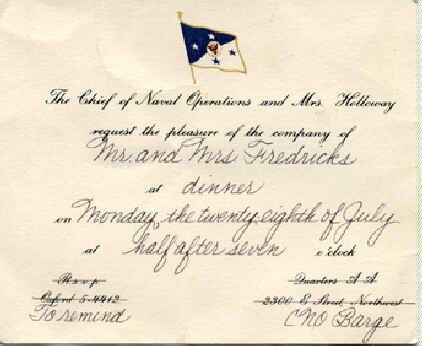
When we got back to the dock, we got hit by a squall. We stood talking in the wheel house and George suggested that maybe Jim might like me to sing for the graduation at Annapolis. Jim demurred, saying, "I can never accept favors from friends." I asked him about something that had been bugging me, for a long time. I said, "Several years ago, Admiral Zumwalt did one of the dumbest things that had ever happened, in the Navy, when he decided to change our uniform, ostensibly to make it more like the other services. What he did was destroy the very thing that made our uniform unique, different from all of those other bozo's" He said, "Well Dick, we did a study on it and determined it would cost $40,000,000 to change it back." I said, "Well Jim, did you ever consider how much money you might save, over the next years... on enlistment bonuses? The uniform is one of the best reasons for a young guy to join the Navy, as the girls just love the tight pants and the bells." He said, "You know, I hadn't thought of that, before. I'll get my uniform troops on that."
One morning, about four months later, Jim called me in New York, asking me if I had seen the front page of the Times. I told him I hadn't looked at it yet and he said to do it and call him back. There it was, lower left had corner, saying Admiral James Holloway, CNO, announced today that the Navy would be returning to the traditional Dress Blues...
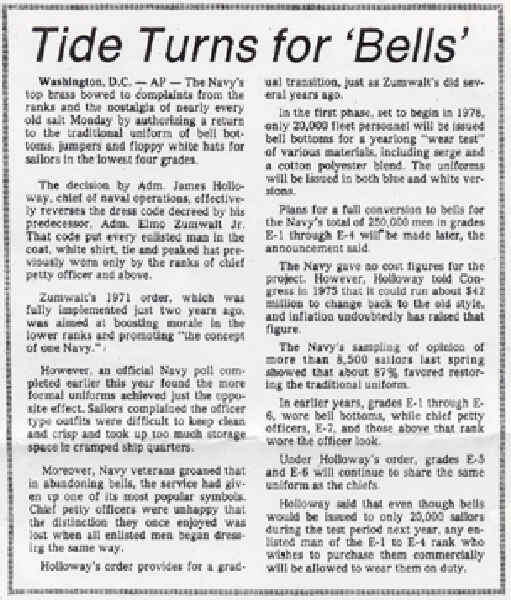
I sent him a flyer, a few months later, about a Live from Lincoln Center performance of the opera, "Manon," that I would be singing. In it, I wear the costume of a Sergeant in the French Army of about 1810, big steel grey coat, rust trim on the collar and cuffs, the same with the tri-corner hat, rust stockings... and a big long sword. I week or so later, I got a note from Jim saying how much he and Dabney had enjoyed the performance, ending with, "Glad to see they're bring the old uniform back."
I sang for the Alfalfa Club again, the next year, and again CNO Jim came up to me to say hello. I told him that I had figured out a way for him to pay me for singing at Annapolis; "Give me a ride with the Blue Angeles." He knew that I am an Aerobatic Pilot, so he said, if you can pass the physical, you've got the ride.
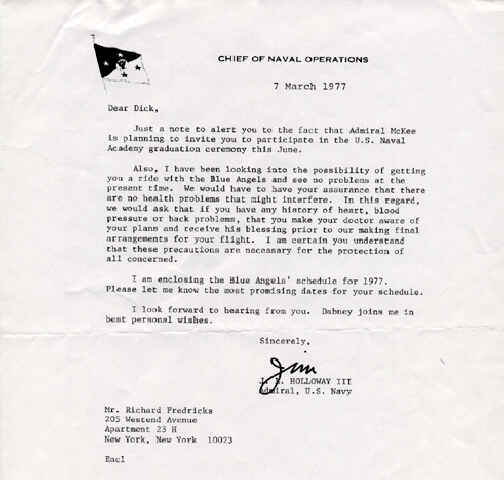
That May, back in Washington for the Opera, a Navy staff car picked me up and took me out to the field where I flew back seat in Blue Angels 7 and got to roll that sucker, one of the high points of my life.
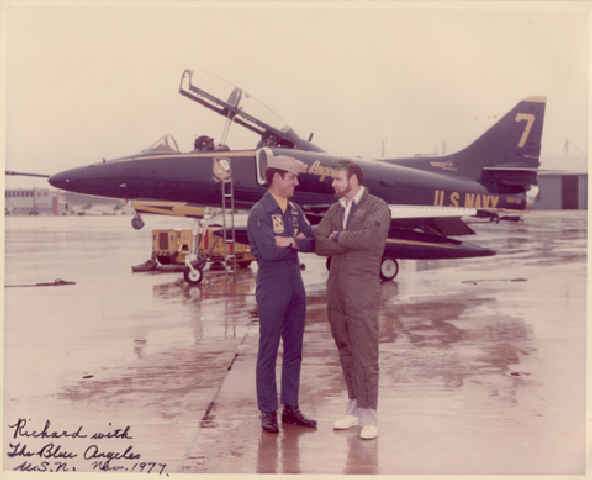
A few days later, I sang the National Anthem at the graduation of Annapolis. Jimmy Carter (remember him?) was the speaker. It was the first time, in the history of the Academy, that a soloist had sung the Anthem. Usually, it was either the Navy/Marine Corp band or choir but this time, it was sung by an ex-Submariner ... a White Hat, yet! I sang the next year, as well. When Jim gave his last dinner at his Naval residence in Washington, I told him I would only accept his invitation if I could sing a dinner concert for his guests. He protested, but he got me the best pianist in the Navy ... and I gave a forty minute concert after dinner, for a select group of twenty of his closest friends. It just shows what you can do, sometimes ... if you can carry a tune!
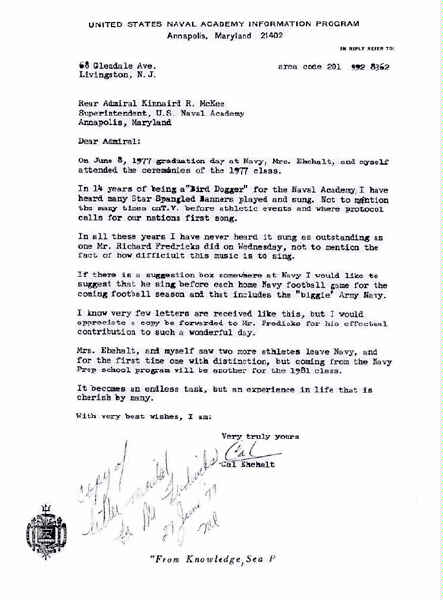
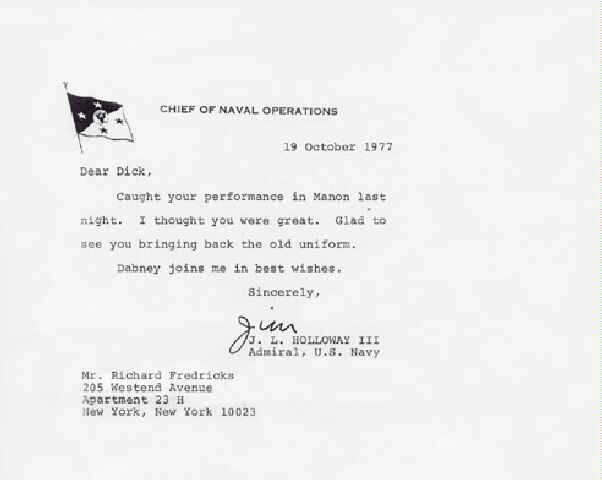
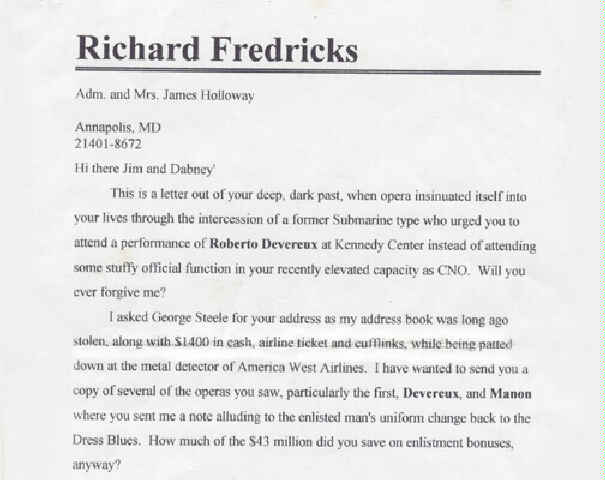
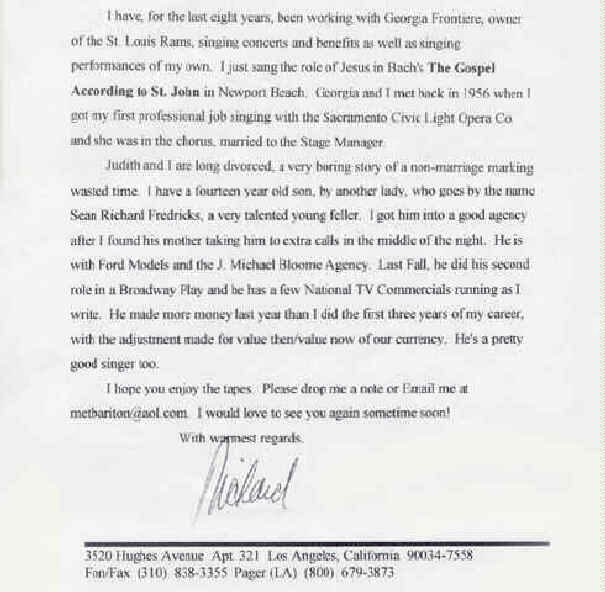
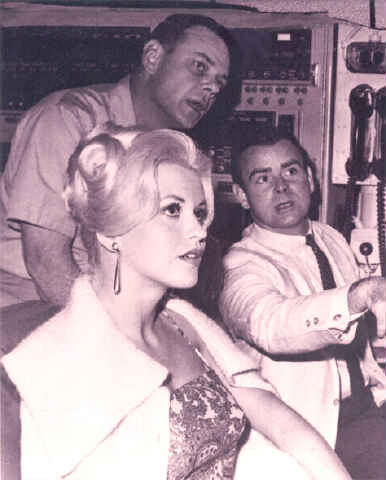
When I was on the boat, my name was Richard F. Schleffel, SO2(SS). The F was for Fredric (after Fredric March, my mom told me), which she turned into Fredricks when I became a professional singer. Ergo, it was Richard Fredricks who sang at the Met.
Here's a camp shot of Richard Fredricks
and Ruth Welting from "The Ballad of Baby Doe"
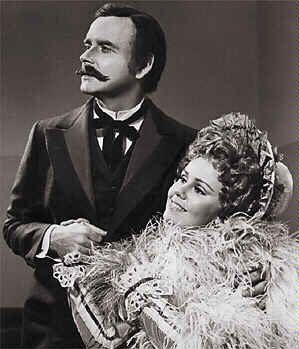
Me as Quixote in La Mancha at the Michgan Opera, in Detroit
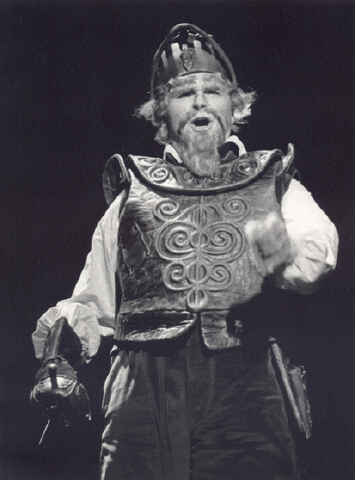
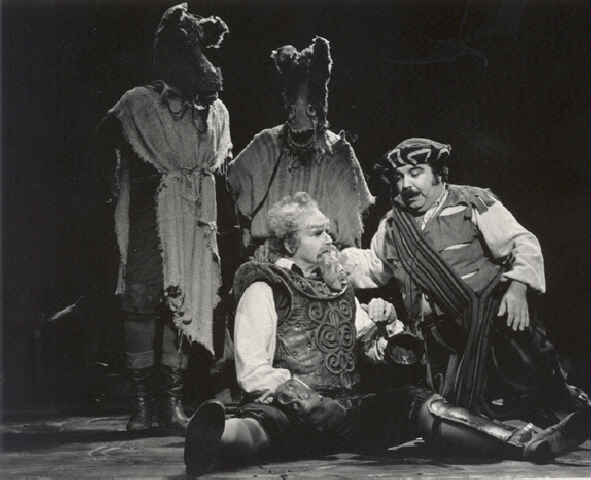
Here I am with my Great
Lakes biplane...
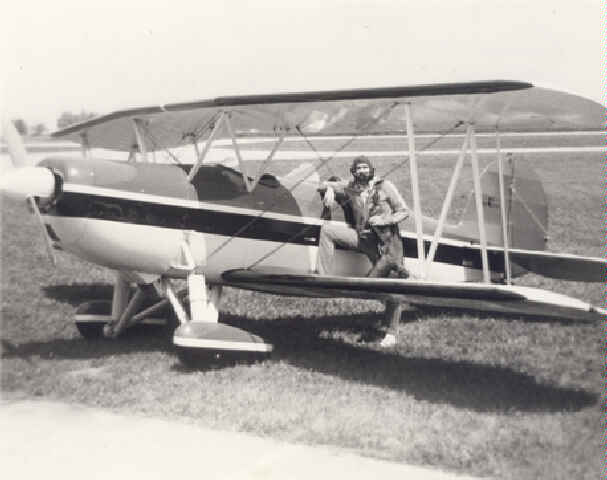
And a photo op of the Reagans with my daughter, Shannon and I...
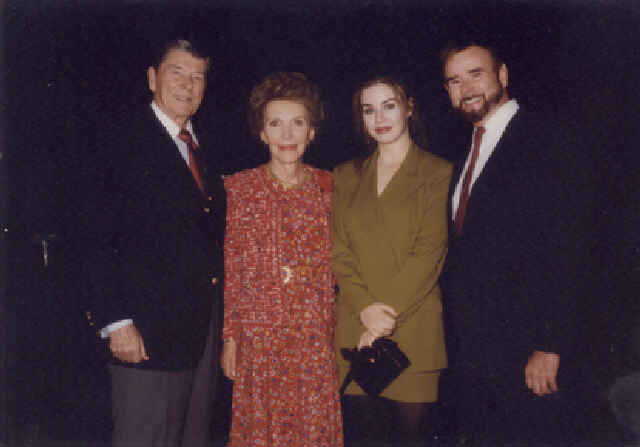
Here's a brief of my performances of note
Biography 2004
RICHARD FREDRICKS
Richard Fredricks, a former leading baritone with the Metropolitan Opera, is recognized as one of today's finest singing actors. At the Metropolitan, he debuted as Don Carlo, in La Forza del Destino, sang Don Giovanni, Barnaba in La Gioconda, Athanael in Thais, the Four Villains in Les Contes D'Hoffmann and others. His debut in opera was with the New York City Opera and, among the more than 40 leading roles sung with this company, are in the operas Rigoletto, I Puritani, Un Ballo un Maschera, Roberto Devereux, Il Barbiere di Siviglia, Attila, Andrea Chenier and Lucia di Lammermoor. His appearances in Hamburg, Frankfurt, Venice, Israel, Brussels, Chile, Mexico, Venezuela, South Africa and Taiwan, as well as with most of the major companies in the U. S. and Canada, attest to his versatility. During his peripatetic career, he has performed in Night Clubs, Plays, in Reviews and has sung in over a score of Operettas and Musicals, as well. These include the leading roles in Kiss Me Kate, Molly Brown, Man of La Mancha, Kismet, Show Boat, 1776, Merry Widow, Music Man, Carousel, Annie Get Your Gun, Desert Song, Bells Are Ringing, Naughty Marietta, Camelot, Carousel and Carnival.
Mr. Fredricks has been a guest soloist with most of the major symphony orchestras in America and is highly esteemed as a recitalist. He sang the first telecast of the prestigious Live from Lincoln Center series in The Ballad of Baby Doe, and in subsequent telecasts of Roberto Devereux, La Traviata, Manon, Lizzie Borden, and in the Opera de Montreal production of Il Trovatore. He was a frequent guest on the Merv Griffin Show, The Dinah Shore Show, The Tonight Show, with Johnny Carson, Dick Cavett Show,, and as himself, in a special Odd Couple segment, with Jack Klugman and Tony Randall.
In addition to his more that 20 appearances at the Hollywood Bowl, over 35 orchestra appearances with Johnny Green in Pops Concerts throughout the country and Israel, Mr. Fredricks appeared in televised performances with the Boston Pops on evenings of Lerner and Loewe and Cole Porter. His four Live from Lincoln Center and Live from WolfTrap included "La Traviata", "Roberto Devereux", "The Ballad of Baby Doe" and "Manon." He also created the role of Jason McFarland in the world premier and subsequent televised performance of "Lizzie Borden." Mr. Fredricks is an artist whose vocal endowments are matched by his theatrical sensitivity and dynamic stage personality.
A year ago, two video tapes where released starring Beverly Sills, Henry Price and Mr. Fredricks in "La Traviata" and "Roberto Devereux" with Ms. Sills and Mr. Fredricks, to compliment the earlier video release of Ms. Sills and Mr. Fredricks in Massenet's "Manon". Mr. Fredricks was featured on the new CD release of the "Durefle' Requiem" with Dr. William Hall and the Master Chorale of Orange County. Mr. Fredricks recently sang the "Belshazzar's Feast", the Orff "Carmina Burana" with Dr. Hall and most recently, the "Cantata; Misericordium" with Dr. Hall at the Kennedy Center in Washington, D. C. Last Spring Mr. Fredricks sang Germont in "La Traviata" with the Downey Symphony and in a concert production of the same work at Pepperdine University. This past December he sang a cameo role as Frank in the Opera Pacific production of "Die Fledermaus" which featured the marvelous spoof of "The Three Tenors", three baritones singing the "Largo al factotum" from the Barber of Seville." Last Spring, he repeated with the Downey Symphony in "An Evening with Lerner and Loewe."
March 1 , 2002, Mr. Fredricks sang a pair of "An Evening with Lerner and Loewe" concerts with the St. Louis Symphony Orchestra also starring Georgia Frontiere and Bill Hayes. In April, he sang the role of Jesus in the J. S Bach oratorio, "The Passion According to Saint John" with the William Hall Master Chorale.
In July, 2002, Mr. Fredricks was the guest soloist with the new Principle Conductor of the Pasadena Pops Orchestra, Lucas Richman, in an All American program "Pop Goes the Fourth!" at Descanso Gardens, in La Canada-Flintridge. Mr. Fredricks sang songs from the Aaron Copland Songbook, a medley of Stephen Foster songs arranged by Mr. Richman, "Ol' Man River" and others from America's rich heritage of song.
Mr. Fredricks sang the role of King Arthur, last Spring, with the Downey Civic Light Opera in their production of Camelot.
For the 2001-2002 scholastic year, Mr. Fredricks was a Visiting Professor of voice at the Flora L. Thornton School of Music, University of Southern California.
Mr. Fredricks recently sang the principle role of Gepetto in a new Musical Comedy production titled Monette and Pinocchio, by Alan Friedman, and at the Zoo Theater in El Paso, Texas. Last November, Mr. Fredricks was the guest artist for The Jeffrey Foundation Awards Benefit. Mr. Fredricks keeps his “pipes” in great form by singing at least ten classic recitals a year.
I have also done a bit of teaching...
Almost Anyone Can Sing
* Have you always wanted
to sing, but thought singing was a gift from the gods and you missed the day the
gifts were handed out...
* You're already singing, but your career is stuck because you just can't
reliably get those elusive high notes...
* You used to sing but now your voice isn't responsive, and you don't know
what's wrong.
Hello! I'm Richard Fredricks, and I've been singing and teaching since I made my debut at New York City Opera, where I sang more than 40 leading roles including Germont in "La traviata" and Lescaut" in "Manon" opposite Beverly Sills, both available on videotape.
My credits at the Metropolitan include Don Carlo in "La Forza del Destino" (my debut in the house), Don Giovanni and Barnada in "La Gioconda," among other roles. I've helped countless professional and students. But more important for you, I've discovered the mechanics of singing. That's right. I have broken down the mysteries and the obfuscations around this treasured art and discovered the exact things you or almost anyone can do to so sing so well you'll scare yourself to half to death. I can teach you support and breathing, and I can tell you exactly where those money high notes are and how to get them.
You don't have to take my word for it. Here are what some masters and some aspiring younger singers have to say: "How would you like to have Michael Jordan give you some tips on basketball? That's what I feel happened with me when I asked Richard Fredricks to help me get back on track," says pop icon Pat Boone. "Through years of increasingly bad vocal habits, terrible sound systems and road weariness, I was beginning to think I had 'lost' it. After just one or two sessions with this master teacher, I had regained my confidence, and have been regaining the ease and expertise I had enjoyed for years. Richard knows, he can teach it, and he cares. I can't imagine a better combination." Andy Williams says: "Two years ago I developed a node on a vocal cord by singing through a serious case of laryngitis. Big mistake! Dr. Berke at UCLA Medical Center prescribed a year long vocal rest, which I took. The node disappeared completely. After this vocal rest, I found it difficult to control my voice the way I used to. A friend of mine told me about Richard Fredricks. He helped me tremendously. After just a few sessions, he had me sounding like like my old self again. If you are a singer who wants to sound like your old self again, by all means to see Richard Fredricks." "The growth and development of my voice over the last seven months ahs been solely due to the quality of teaching that I have been receiving from Mr. Fredricks," write USC student Michael J. Elson. "I must be honest that, as a student, I was not entirely thrilled with my vocal improvement over the previous two years and now that I have studied with Professor Fredricks, I dare not trust my voice to just anyone ever again." "My results with Mr. Fredricks speak for themselves, as evidenced by my student arrival at the leading baritone level," writes another USC student, E. Philip Schneider. "He has literally given me a high range in six months." Says Wesley Morrow, another USC student: "Richard Fredricks is by far the best voice teacher I have ever had. Over the last year, my vocal tone has gained in volume, focus and beauty, and the top of my range has gone from a shaky F to a solid performance quality A."
I
like to tell prospective students that they should ask their teachers to
demonstrate how well they sing, and if they hem and haw and otherwise excuse
themselves and decline, run for the hills. I can demonstrate everything I want
you to learn. My home page will answer many questions and make more...
click here.
Richard Fredricks
To return to memories of the SS 320,
click here.
To return to the main page of the SS 320, click here.